Financial Management Project: Theory and Application (Project 1)
VerifiedAdded on 2020/06/03
|11
|2595
|118
Project
AI Summary
This financial management project delves into investment appraisal techniques, encompassing Net Present Value (NPV), Internal Rate of Return (IRR), and Accounting Rate of Return (ARR) to evaluate project viability. Part 1 critically assesses these techniques, providing calculations and analysis of cash flows, costs, and profits. It also examines the impact of business expansion on stakeholders. Part 2 consists of true/false questions and multiple-choice questions that test understanding of capital budgeting, financial theories (like modern portfolio theory and income theory), and investment decision-making. The project covers topics such as salvage value, expected return calculation, and the comparison of project profitability using NPV and IRR. It emphasizes the importance of cash flow analysis and decision-making based on project NPV. The project also touches on the Modified Internal Rate of Return (MIRR) and the limitations of the payback period method.
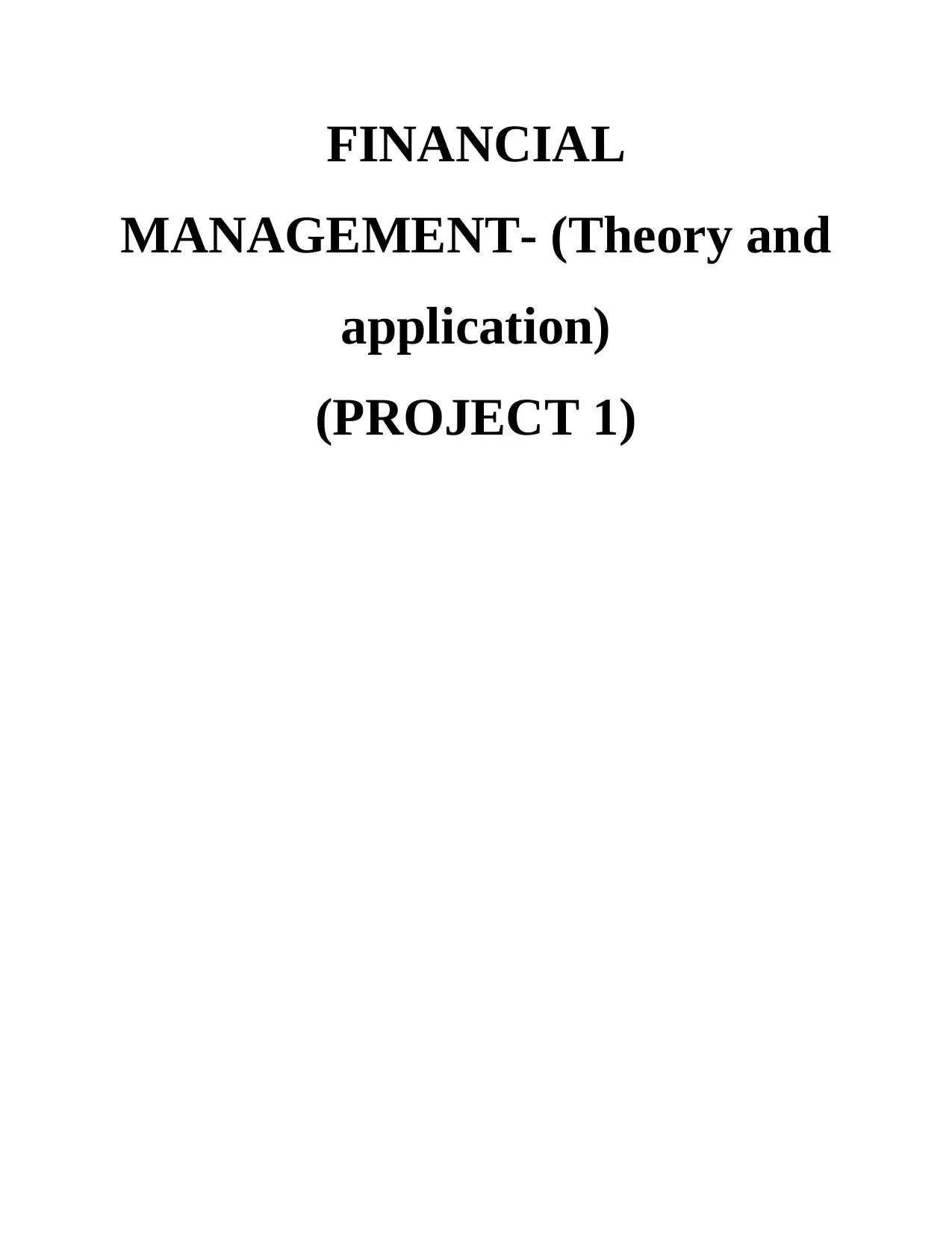
FINANCIAL
MANAGEMENT- (Theory and
application)
(PROJECT 1)
MANAGEMENT- (Theory and
application)
(PROJECT 1)
Paraphrase This Document
Need a fresh take? Get an instant paraphrase of this document with our AI Paraphraser
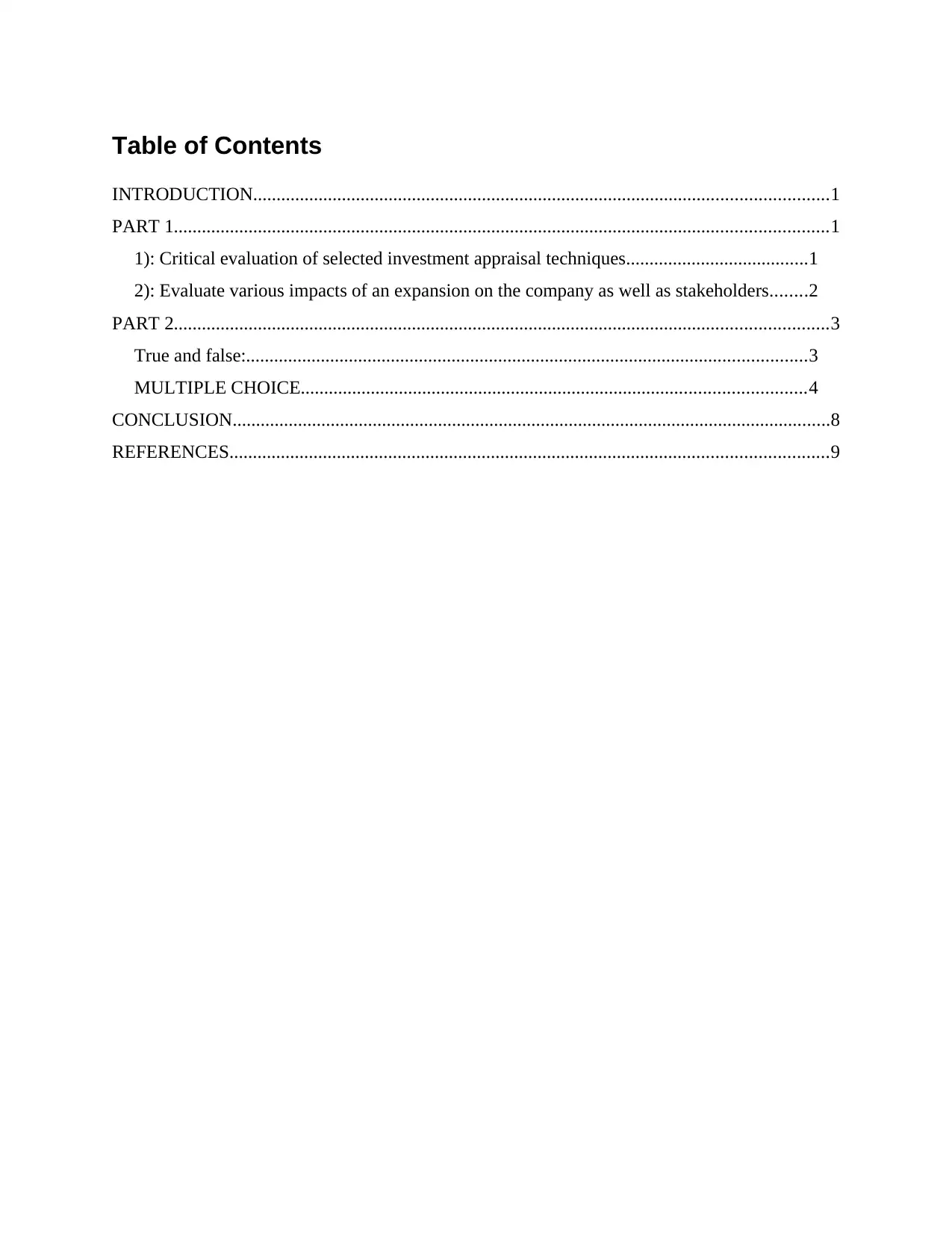
Table of Contents
INTRODUCTION...........................................................................................................................1
PART 1............................................................................................................................................1
1): Critical evaluation of selected investment appraisal techniques.......................................1
2): Evaluate various impacts of an expansion on the company as well as stakeholders........2
PART 2............................................................................................................................................3
True and false:........................................................................................................................3
MULTIPLE CHOICE............................................................................................................4
CONCLUSION................................................................................................................................8
REFERENCES................................................................................................................................9
INTRODUCTION...........................................................................................................................1
PART 1............................................................................................................................................1
1): Critical evaluation of selected investment appraisal techniques.......................................1
2): Evaluate various impacts of an expansion on the company as well as stakeholders........2
PART 2............................................................................................................................................3
True and false:........................................................................................................................3
MULTIPLE CHOICE............................................................................................................4
CONCLUSION................................................................................................................................8
REFERENCES................................................................................................................................9
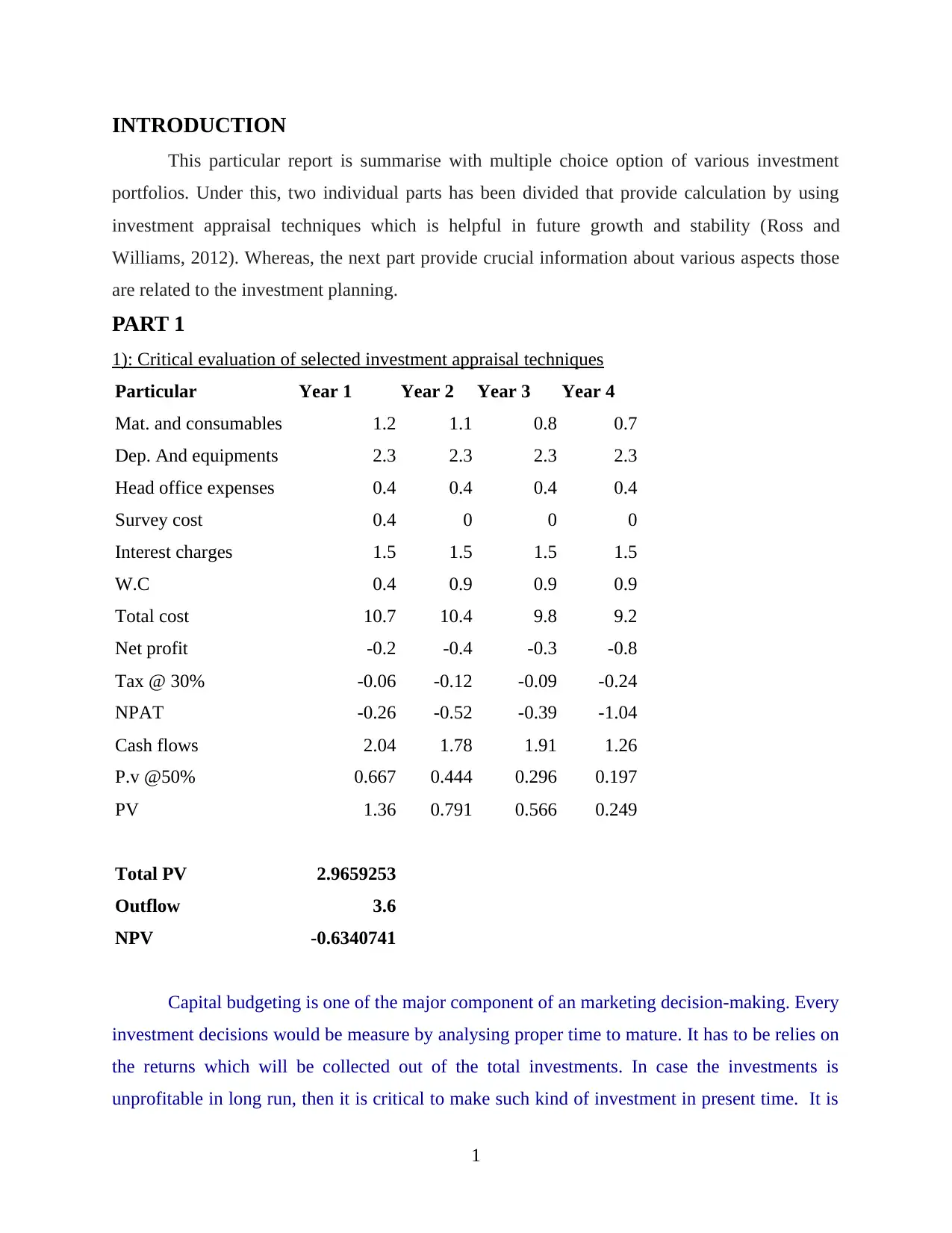
INTRODUCTION
This particular report is summarise with multiple choice option of various investment
portfolios. Under this, two individual parts has been divided that provide calculation by using
investment appraisal techniques which is helpful in future growth and stability (Ross and
Williams, 2012). Whereas, the next part provide crucial information about various aspects those
are related to the investment planning.
PART 1
1): Critical evaluation of selected investment appraisal techniques
Particular Year 1 Year 2 Year 3 Year 4
Mat. and consumables 1.2 1.1 0.8 0.7
Dep. And equipments 2.3 2.3 2.3 2.3
Head office expenses 0.4 0.4 0.4 0.4
Survey cost 0.4 0 0 0
Interest charges 1.5 1.5 1.5 1.5
W.C 0.4 0.9 0.9 0.9
Total cost 10.7 10.4 9.8 9.2
Net profit -0.2 -0.4 -0.3 -0.8
Tax @ 30% -0.06 -0.12 -0.09 -0.24
NPAT -0.26 -0.52 -0.39 -1.04
Cash flows 2.04 1.78 1.91 1.26
P.v @50% 0.667 0.444 0.296 0.197
PV 1.36 0.791 0.566 0.249
Total PV 2.9659253
Outflow 3.6
NPV -0.6340741
Capital budgeting is one of the major component of an marketing decision-making. Every
investment decisions would be measure by analysing proper time to mature. It has to be relies on
the returns which will be collected out of the total investments. In case the investments is
unprofitable in long run, then it is critical to make such kind of investment in present time. It is
1
This particular report is summarise with multiple choice option of various investment
portfolios. Under this, two individual parts has been divided that provide calculation by using
investment appraisal techniques which is helpful in future growth and stability (Ross and
Williams, 2012). Whereas, the next part provide crucial information about various aspects those
are related to the investment planning.
PART 1
1): Critical evaluation of selected investment appraisal techniques
Particular Year 1 Year 2 Year 3 Year 4
Mat. and consumables 1.2 1.1 0.8 0.7
Dep. And equipments 2.3 2.3 2.3 2.3
Head office expenses 0.4 0.4 0.4 0.4
Survey cost 0.4 0 0 0
Interest charges 1.5 1.5 1.5 1.5
W.C 0.4 0.9 0.9 0.9
Total cost 10.7 10.4 9.8 9.2
Net profit -0.2 -0.4 -0.3 -0.8
Tax @ 30% -0.06 -0.12 -0.09 -0.24
NPAT -0.26 -0.52 -0.39 -1.04
Cash flows 2.04 1.78 1.91 1.26
P.v @50% 0.667 0.444 0.296 0.197
PV 1.36 0.791 0.566 0.249
Total PV 2.9659253
Outflow 3.6
NPV -0.6340741
Capital budgeting is one of the major component of an marketing decision-making. Every
investment decisions would be measure by analysing proper time to mature. It has to be relies on
the returns which will be collected out of the total investments. In case the investments is
unprofitable in long run, then it is critical to make such kind of investment in present time. It is
1
⊘ This is a preview!⊘
Do you want full access?
Subscribe today to unlock all pages.

Trusted by 1+ million students worldwide
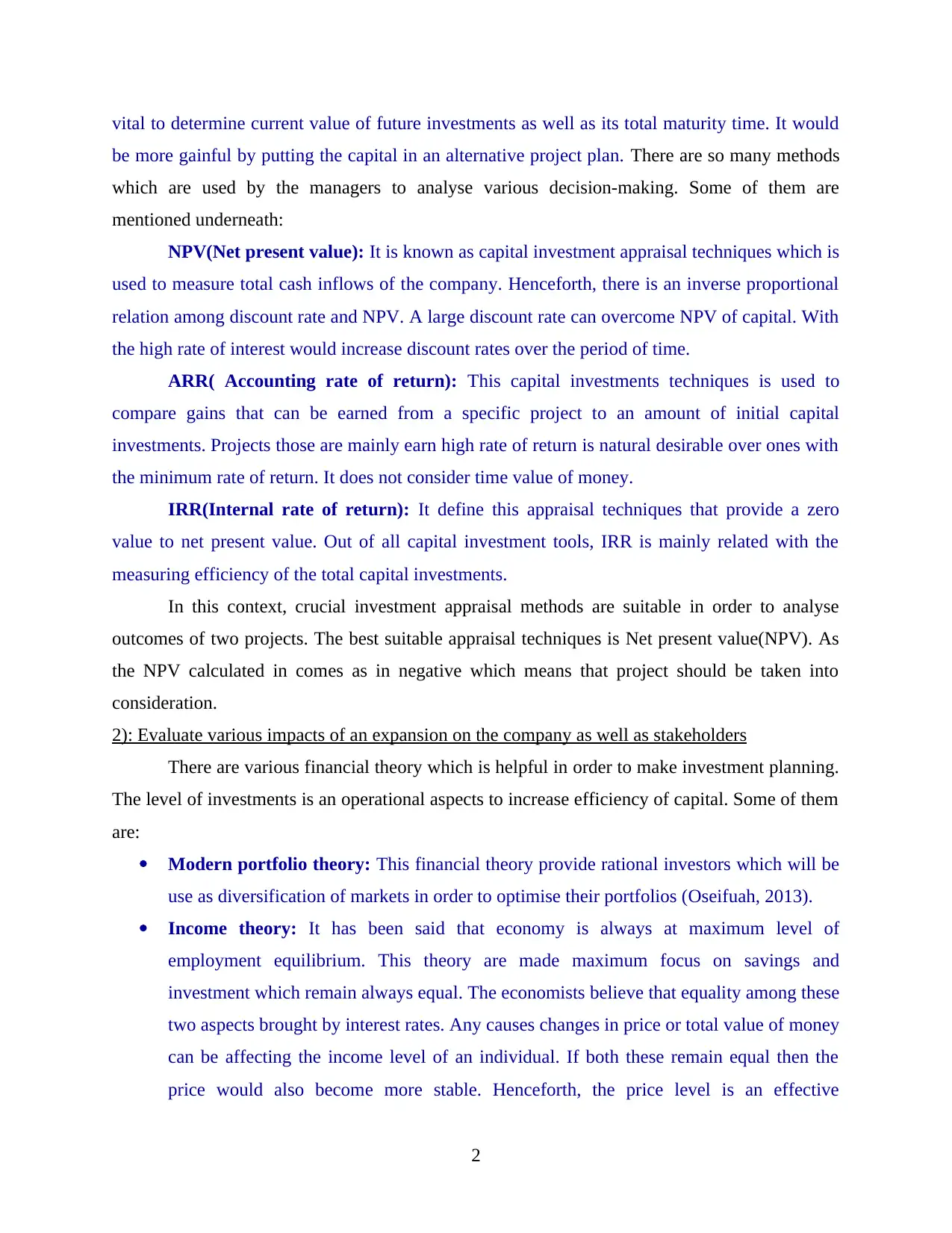
vital to determine current value of future investments as well as its total maturity time. It would
be more gainful by putting the capital in an alternative project plan. There are so many methods
which are used by the managers to analyse various decision-making. Some of them are
mentioned underneath:
NPV(Net present value): It is known as capital investment appraisal techniques which is
used to measure total cash inflows of the company. Henceforth, there is an inverse proportional
relation among discount rate and NPV. A large discount rate can overcome NPV of capital. With
the high rate of interest would increase discount rates over the period of time.
ARR( Accounting rate of return): This capital investments techniques is used to
compare gains that can be earned from a specific project to an amount of initial capital
investments. Projects those are mainly earn high rate of return is natural desirable over ones with
the minimum rate of return. It does not consider time value of money.
IRR(Internal rate of return): It define this appraisal techniques that provide a zero
value to net present value. Out of all capital investment tools, IRR is mainly related with the
measuring efficiency of the total capital investments.
In this context, crucial investment appraisal methods are suitable in order to analyse
outcomes of two projects. The best suitable appraisal techniques is Net present value(NPV). As
the NPV calculated in comes as in negative which means that project should be taken into
consideration.
2): Evaluate various impacts of an expansion on the company as well as stakeholders
There are various financial theory which is helpful in order to make investment planning.
The level of investments is an operational aspects to increase efficiency of capital. Some of them
are:
Modern portfolio theory: This financial theory provide rational investors which will be
use as diversification of markets in order to optimise their portfolios (Oseifuah, 2013).
Income theory: It has been said that economy is always at maximum level of
employment equilibrium. This theory are made maximum focus on savings and
investment which remain always equal. The economists believe that equality among these
two aspects brought by interest rates. Any causes changes in price or total value of money
can be affecting the income level of an individual. If both these remain equal then the
price would also become more stable. Henceforth, the price level is an effective
2
be more gainful by putting the capital in an alternative project plan. There are so many methods
which are used by the managers to analyse various decision-making. Some of them are
mentioned underneath:
NPV(Net present value): It is known as capital investment appraisal techniques which is
used to measure total cash inflows of the company. Henceforth, there is an inverse proportional
relation among discount rate and NPV. A large discount rate can overcome NPV of capital. With
the high rate of interest would increase discount rates over the period of time.
ARR( Accounting rate of return): This capital investments techniques is used to
compare gains that can be earned from a specific project to an amount of initial capital
investments. Projects those are mainly earn high rate of return is natural desirable over ones with
the minimum rate of return. It does not consider time value of money.
IRR(Internal rate of return): It define this appraisal techniques that provide a zero
value to net present value. Out of all capital investment tools, IRR is mainly related with the
measuring efficiency of the total capital investments.
In this context, crucial investment appraisal methods are suitable in order to analyse
outcomes of two projects. The best suitable appraisal techniques is Net present value(NPV). As
the NPV calculated in comes as in negative which means that project should be taken into
consideration.
2): Evaluate various impacts of an expansion on the company as well as stakeholders
There are various financial theory which is helpful in order to make investment planning.
The level of investments is an operational aspects to increase efficiency of capital. Some of them
are:
Modern portfolio theory: This financial theory provide rational investors which will be
use as diversification of markets in order to optimise their portfolios (Oseifuah, 2013).
Income theory: It has been said that economy is always at maximum level of
employment equilibrium. This theory are made maximum focus on savings and
investment which remain always equal. The economists believe that equality among these
two aspects brought by interest rates. Any causes changes in price or total value of money
can be affecting the income level of an individual. If both these remain equal then the
price would also become more stable. Henceforth, the price level is an effective
2
Paraphrase This Document
Need a fresh take? Get an instant paraphrase of this document with our AI Paraphraser

consequences of modification in total income rather than total quantity of capital
investments.
Portfolios theory: It is known as modern theory which determine how risk aversion to an
investors can build portfolios to increase or gain expected return which is based on a
specific level of market risk. It would focuses on that particular risk which is inherent
part of increasing payment. The primary objectives of this particular investment theory is
to increase a expected return by making vital changes in various assets in a group of
portfolios. This theory would explain some specific aspects about how an investors can
deal or reduce overall risk which is been keeping a diversify portfolios of assets.
International expansion of business is a tricky proposition for a wide variety of reasons.
Uncertainty revolve around profitability and market position would lead to conflicting situations
within an organisation. Furthermore, responsible for managing large growth which is evenly
distributed with an organisation. High growth companies are frequently operating with a lean
start-up costs which include desire to reduce the organisations tax and legal presences in
domestic nation. The economy has become more competitive as companies of every size seek to
increase beyond domestic nations. Operating in multiple nation can offers huge insularity from
economic downturns in one or two location.
There are various implication those are affecting growth of a business that make huge
impacts on their stakeholders. Some of them are discuss underneath:
Shareholder: It is more likely to provide advantages from any increase gains that would
bring expansion. Likewise, they might be asked to purchase more shares and invest
maximum money in order to increase business.
Employees: They would surely get benefited from providing huge job security at wide
business those are likely to fail than small business firm. Basically, a large companies
tend to be more systematic and employees can feel less associated in operating their
business operations. This will results in joining trade union in respect to protect their
interest than workers in mid term business organisation.
Government: They will be able to collect more taxes as the business become more
profitable. Likewise, few businesses can become so powerful that would make huge
impacts on the business growth and their sustainability.
3
investments.
Portfolios theory: It is known as modern theory which determine how risk aversion to an
investors can build portfolios to increase or gain expected return which is based on a
specific level of market risk. It would focuses on that particular risk which is inherent
part of increasing payment. The primary objectives of this particular investment theory is
to increase a expected return by making vital changes in various assets in a group of
portfolios. This theory would explain some specific aspects about how an investors can
deal or reduce overall risk which is been keeping a diversify portfolios of assets.
International expansion of business is a tricky proposition for a wide variety of reasons.
Uncertainty revolve around profitability and market position would lead to conflicting situations
within an organisation. Furthermore, responsible for managing large growth which is evenly
distributed with an organisation. High growth companies are frequently operating with a lean
start-up costs which include desire to reduce the organisations tax and legal presences in
domestic nation. The economy has become more competitive as companies of every size seek to
increase beyond domestic nations. Operating in multiple nation can offers huge insularity from
economic downturns in one or two location.
There are various implication those are affecting growth of a business that make huge
impacts on their stakeholders. Some of them are discuss underneath:
Shareholder: It is more likely to provide advantages from any increase gains that would
bring expansion. Likewise, they might be asked to purchase more shares and invest
maximum money in order to increase business.
Employees: They would surely get benefited from providing huge job security at wide
business those are likely to fail than small business firm. Basically, a large companies
tend to be more systematic and employees can feel less associated in operating their
business operations. This will results in joining trade union in respect to protect their
interest than workers in mid term business organisation.
Government: They will be able to collect more taxes as the business become more
profitable. Likewise, few businesses can become so powerful that would make huge
impacts on the business growth and their sustainability.
3
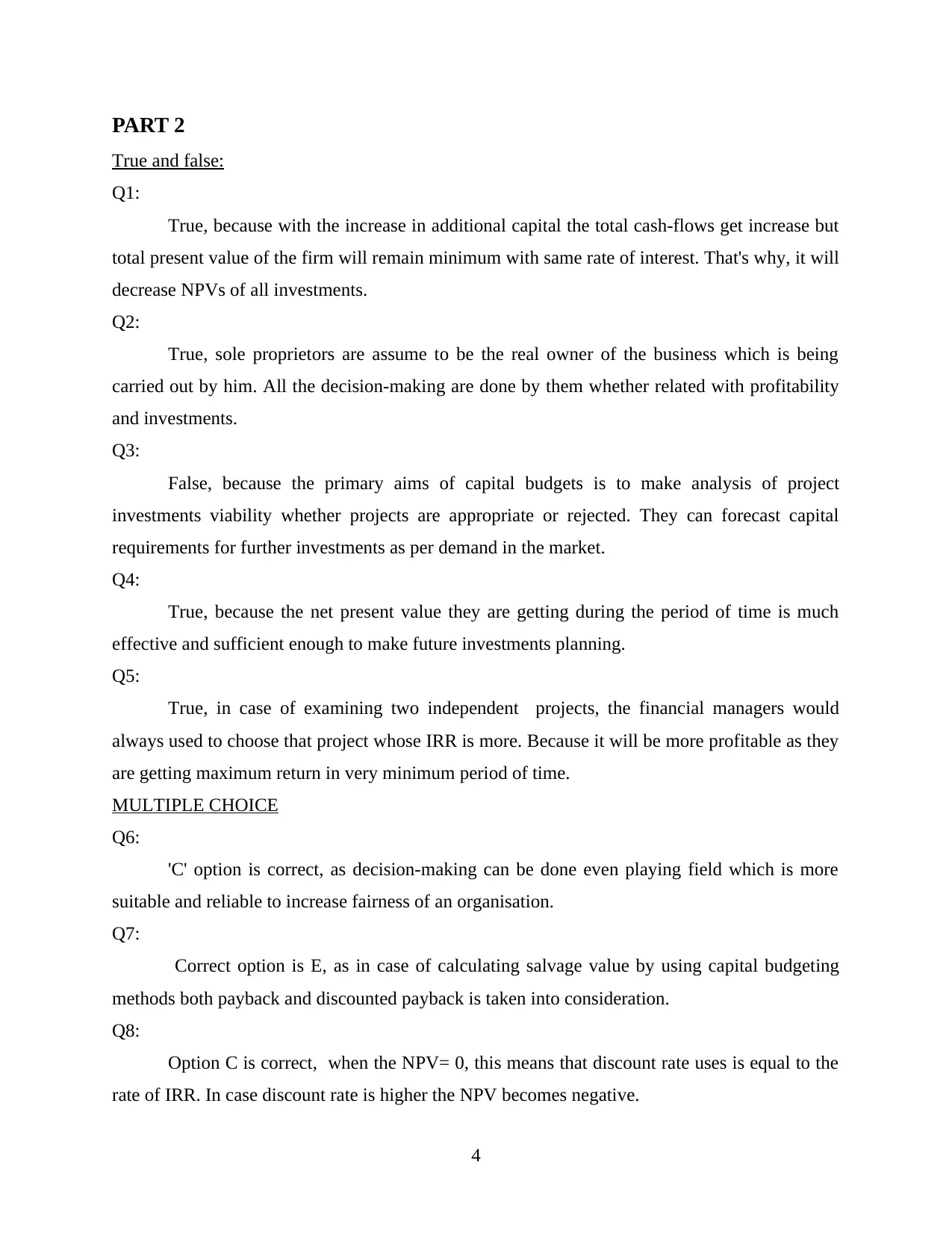
PART 2
True and false:
Q1:
True, because with the increase in additional capital the total cash-flows get increase but
total present value of the firm will remain minimum with same rate of interest. That's why, it will
decrease NPVs of all investments.
Q2:
True, sole proprietors are assume to be the real owner of the business which is being
carried out by him. All the decision-making are done by them whether related with profitability
and investments.
Q3:
False, because the primary aims of capital budgets is to make analysis of project
investments viability whether projects are appropriate or rejected. They can forecast capital
requirements for further investments as per demand in the market.
Q4:
True, because the net present value they are getting during the period of time is much
effective and sufficient enough to make future investments planning.
Q5:
True, in case of examining two independent projects, the financial managers would
always used to choose that project whose IRR is more. Because it will be more profitable as they
are getting maximum return in very minimum period of time.
MULTIPLE CHOICE
Q6:
'C' option is correct, as decision-making can be done even playing field which is more
suitable and reliable to increase fairness of an organisation.
Q7:
Correct option is E, as in case of calculating salvage value by using capital budgeting
methods both payback and discounted payback is taken into consideration.
Q8:
Option C is correct, when the NPV= 0, this means that discount rate uses is equal to the
rate of IRR. In case discount rate is higher the NPV becomes negative.
4
True and false:
Q1:
True, because with the increase in additional capital the total cash-flows get increase but
total present value of the firm will remain minimum with same rate of interest. That's why, it will
decrease NPVs of all investments.
Q2:
True, sole proprietors are assume to be the real owner of the business which is being
carried out by him. All the decision-making are done by them whether related with profitability
and investments.
Q3:
False, because the primary aims of capital budgets is to make analysis of project
investments viability whether projects are appropriate or rejected. They can forecast capital
requirements for further investments as per demand in the market.
Q4:
True, because the net present value they are getting during the period of time is much
effective and sufficient enough to make future investments planning.
Q5:
True, in case of examining two independent projects, the financial managers would
always used to choose that project whose IRR is more. Because it will be more profitable as they
are getting maximum return in very minimum period of time.
MULTIPLE CHOICE
Q6:
'C' option is correct, as decision-making can be done even playing field which is more
suitable and reliable to increase fairness of an organisation.
Q7:
Correct option is E, as in case of calculating salvage value by using capital budgeting
methods both payback and discounted payback is taken into consideration.
Q8:
Option C is correct, when the NPV= 0, this means that discount rate uses is equal to the
rate of IRR. In case discount rate is higher the NPV becomes negative.
4
⊘ This is a preview!⊘
Do you want full access?
Subscribe today to unlock all pages.

Trusted by 1+ million students worldwide
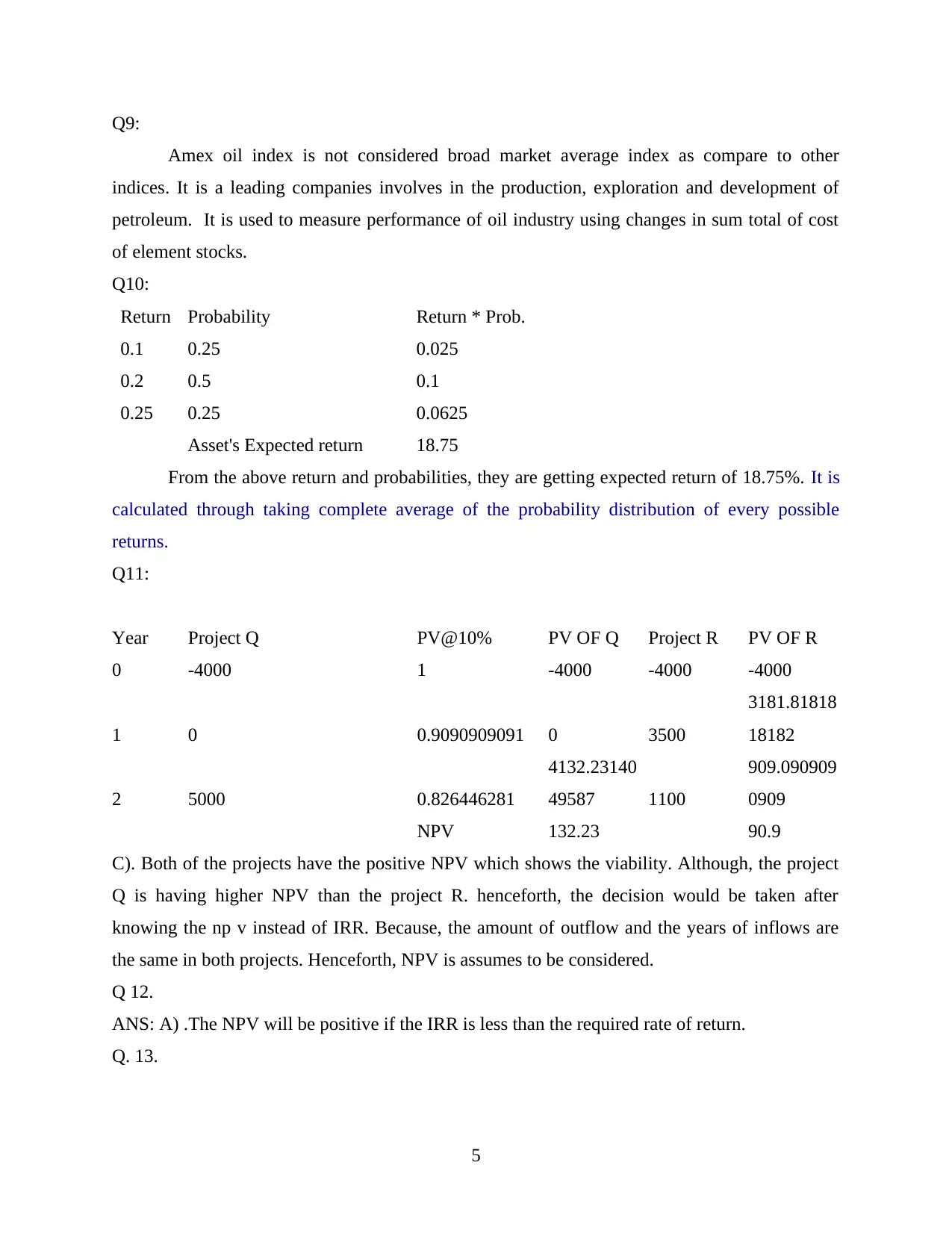
Q9:
Amex oil index is not considered broad market average index as compare to other
indices. It is a leading companies involves in the production, exploration and development of
petroleum. It is used to measure performance of oil industry using changes in sum total of cost
of element stocks.
Q10:
Return Probability Return * Prob.
0.1 0.25 0.025
0.2 0.5 0.1
0.25 0.25 0.0625
Asset's Expected return 18.75
From the above return and probabilities, they are getting expected return of 18.75%. It is
calculated through taking complete average of the probability distribution of every possible
returns.
Q11:
Year Project Q PV@10% PV OF Q Project R PV OF R
0 -4000 1 -4000 -4000 -4000
1 0 0.9090909091 0 3500
3181.81818
18182
2 5000 0.826446281
4132.23140
49587 1100
909.090909
0909
NPV 132.23 90.9
C). Both of the projects have the positive NPV which shows the viability. Although, the project
Q is having higher NPV than the project R. henceforth, the decision would be taken after
knowing the np v instead of IRR. Because, the amount of outflow and the years of inflows are
the same in both projects. Henceforth, NPV is assumes to be considered.
Q 12.
ANS: A) .The NPV will be positive if the IRR is less than the required rate of return.
Q. 13.
5
Amex oil index is not considered broad market average index as compare to other
indices. It is a leading companies involves in the production, exploration and development of
petroleum. It is used to measure performance of oil industry using changes in sum total of cost
of element stocks.
Q10:
Return Probability Return * Prob.
0.1 0.25 0.025
0.2 0.5 0.1
0.25 0.25 0.0625
Asset's Expected return 18.75
From the above return and probabilities, they are getting expected return of 18.75%. It is
calculated through taking complete average of the probability distribution of every possible
returns.
Q11:
Year Project Q PV@10% PV OF Q Project R PV OF R
0 -4000 1 -4000 -4000 -4000
1 0 0.9090909091 0 3500
3181.81818
18182
2 5000 0.826446281
4132.23140
49587 1100
909.090909
0909
NPV 132.23 90.9
C). Both of the projects have the positive NPV which shows the viability. Although, the project
Q is having higher NPV than the project R. henceforth, the decision would be taken after
knowing the np v instead of IRR. Because, the amount of outflow and the years of inflows are
the same in both projects. Henceforth, NPV is assumes to be considered.
Q 12.
ANS: A) .The NPV will be positive if the IRR is less than the required rate of return.
Q. 13.
5
Paraphrase This Document
Need a fresh take? Get an instant paraphrase of this document with our AI Paraphraser
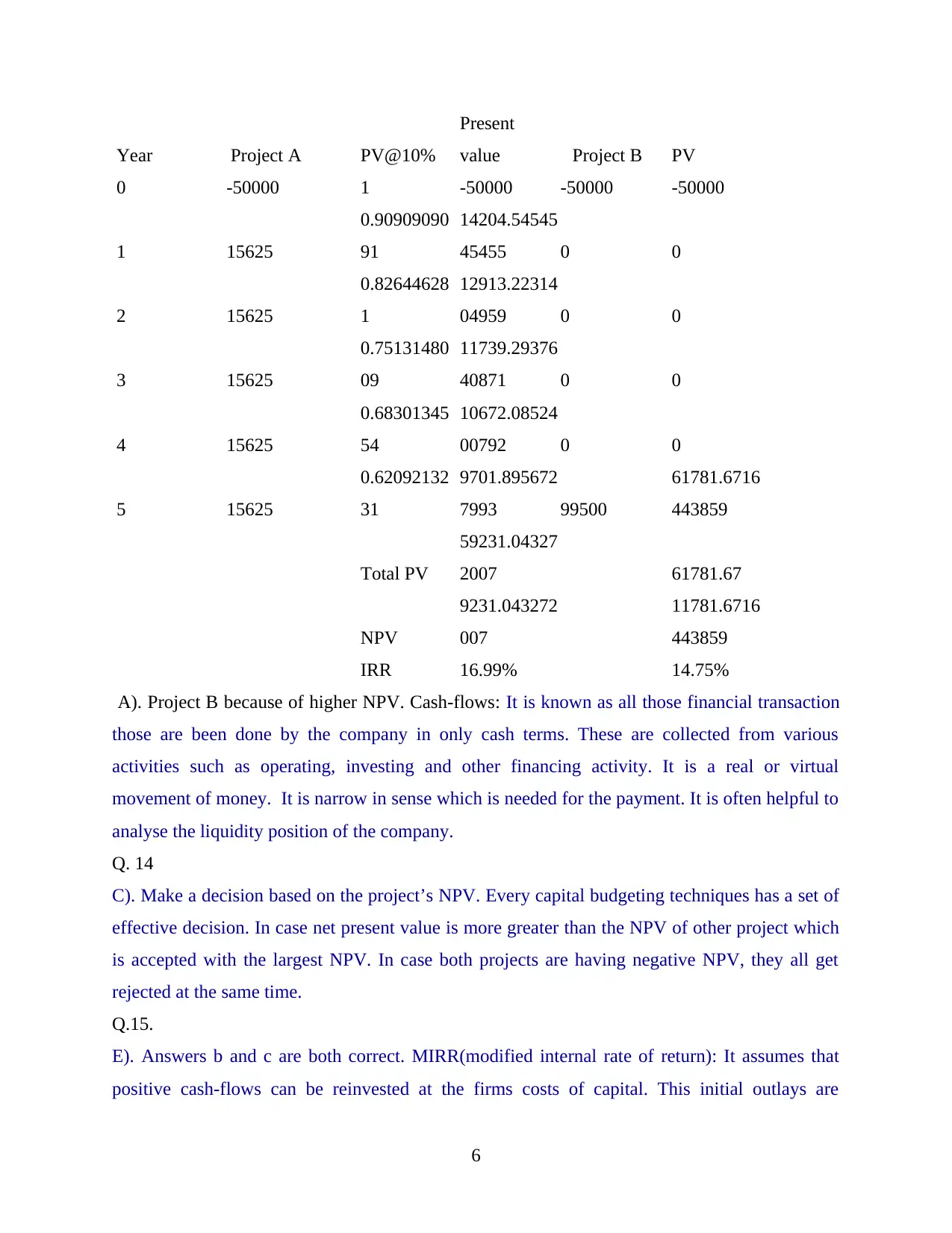
Year Project A PV@10%
Present
value Project B PV
0 -50000 1 -50000 -50000 -50000
1 15625
0.90909090
91
14204.54545
45455 0 0
2 15625
0.82644628
1
12913.22314
04959 0 0
3 15625
0.75131480
09
11739.29376
40871 0 0
4 15625
0.68301345
54
10672.08524
00792 0 0
5 15625
0.62092132
31
9701.895672
7993 99500
61781.6716
443859
Total PV
59231.04327
2007 61781.67
NPV
9231.043272
007
11781.6716
443859
IRR 16.99% 14.75%
A). Project B because of higher NPV. Cash-flows: It is known as all those financial transaction
those are been done by the company in only cash terms. These are collected from various
activities such as operating, investing and other financing activity. It is a real or virtual
movement of money. It is narrow in sense which is needed for the payment. It is often helpful to
analyse the liquidity position of the company.
Q. 14
C). Make a decision based on the project’s NPV. Every capital budgeting techniques has a set of
effective decision. In case net present value is more greater than the NPV of other project which
is accepted with the largest NPV. In case both projects are having negative NPV, they all get
rejected at the same time.
Q.15.
E). Answers b and c are both correct. MIRR(modified internal rate of return): It assumes that
positive cash-flows can be reinvested at the firms costs of capital. This initial outlays are
6
Present
value Project B PV
0 -50000 1 -50000 -50000 -50000
1 15625
0.90909090
91
14204.54545
45455 0 0
2 15625
0.82644628
1
12913.22314
04959 0 0
3 15625
0.75131480
09
11739.29376
40871 0 0
4 15625
0.68301345
54
10672.08524
00792 0 0
5 15625
0.62092132
31
9701.895672
7993 99500
61781.6716
443859
Total PV
59231.04327
2007 61781.67
NPV
9231.043272
007
11781.6716
443859
IRR 16.99% 14.75%
A). Project B because of higher NPV. Cash-flows: It is known as all those financial transaction
those are been done by the company in only cash terms. These are collected from various
activities such as operating, investing and other financing activity. It is a real or virtual
movement of money. It is narrow in sense which is needed for the payment. It is often helpful to
analyse the liquidity position of the company.
Q. 14
C). Make a decision based on the project’s NPV. Every capital budgeting techniques has a set of
effective decision. In case net present value is more greater than the NPV of other project which
is accepted with the largest NPV. In case both projects are having negative NPV, they all get
rejected at the same time.
Q.15.
E). Answers b and c are both correct. MIRR(modified internal rate of return): It assumes that
positive cash-flows can be reinvested at the firms costs of capital. This initial outlays are
6
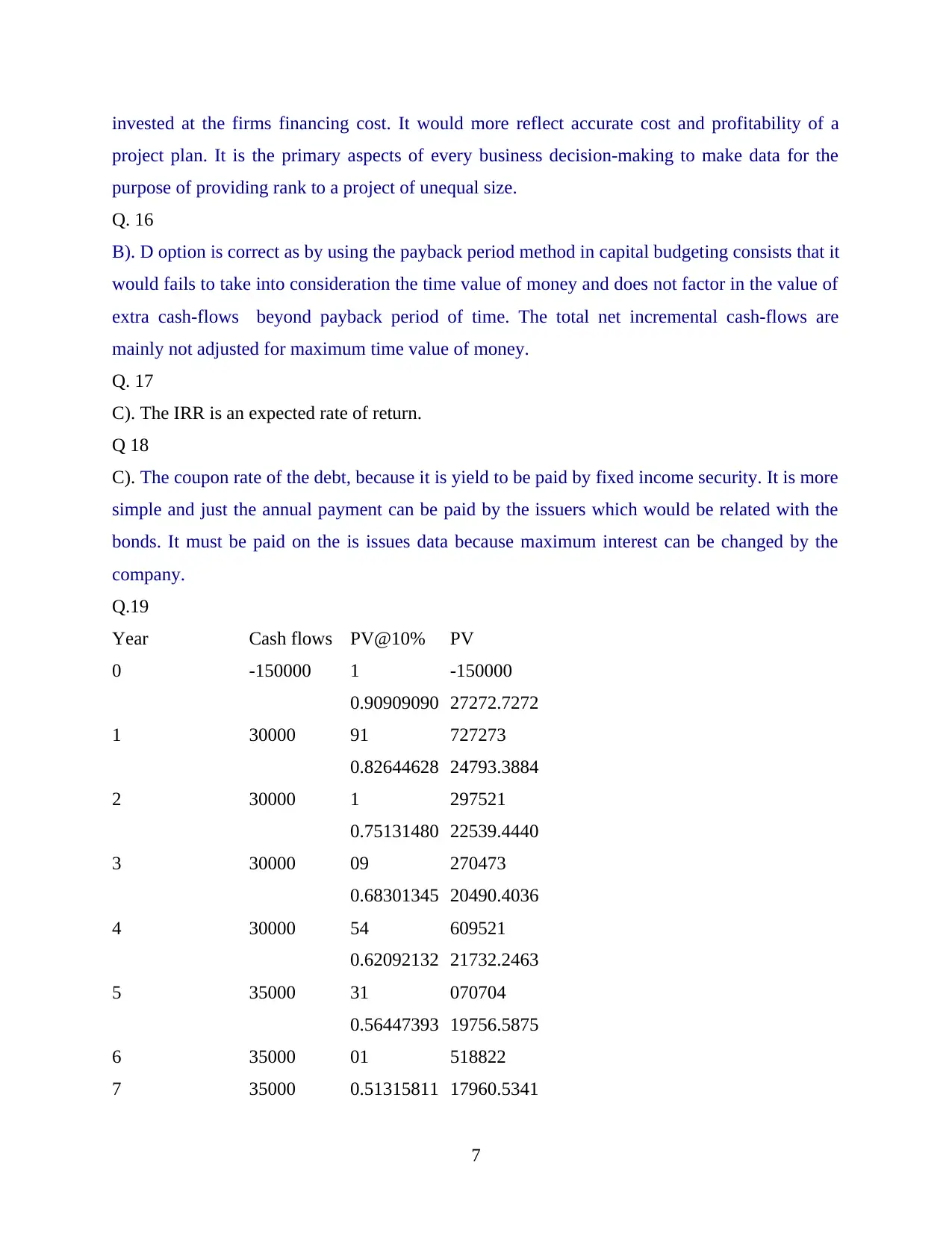
invested at the firms financing cost. It would more reflect accurate cost and profitability of a
project plan. It is the primary aspects of every business decision-making to make data for the
purpose of providing rank to a project of unequal size.
Q. 16
B). D option is correct as by using the payback period method in capital budgeting consists that it
would fails to take into consideration the time value of money and does not factor in the value of
extra cash-flows beyond payback period of time. The total net incremental cash-flows are
mainly not adjusted for maximum time value of money.
Q. 17
C). The IRR is an expected rate of return.
Q 18
C). The coupon rate of the debt, because it is yield to be paid by fixed income security. It is more
simple and just the annual payment can be paid by the issuers which would be related with the
bonds. It must be paid on the is issues data because maximum interest can be changed by the
company.
Q.19
Year Cash flows PV@10% PV
0 -150000 1 -150000
1 30000
0.90909090
91
27272.7272
727273
2 30000
0.82644628
1
24793.3884
297521
3 30000
0.75131480
09
22539.4440
270473
4 30000
0.68301345
54
20490.4036
609521
5 35000
0.62092132
31
21732.2463
070704
6 35000
0.56447393
01
19756.5875
518822
7 35000 0.51315811 17960.5341
7
project plan. It is the primary aspects of every business decision-making to make data for the
purpose of providing rank to a project of unequal size.
Q. 16
B). D option is correct as by using the payback period method in capital budgeting consists that it
would fails to take into consideration the time value of money and does not factor in the value of
extra cash-flows beyond payback period of time. The total net incremental cash-flows are
mainly not adjusted for maximum time value of money.
Q. 17
C). The IRR is an expected rate of return.
Q 18
C). The coupon rate of the debt, because it is yield to be paid by fixed income security. It is more
simple and just the annual payment can be paid by the issuers which would be related with the
bonds. It must be paid on the is issues data because maximum interest can be changed by the
company.
Q.19
Year Cash flows PV@10% PV
0 -150000 1 -150000
1 30000
0.90909090
91
27272.7272
727273
2 30000
0.82644628
1
24793.3884
297521
3 30000
0.75131480
09
22539.4440
270473
4 30000
0.68301345
54
20490.4036
609521
5 35000
0.62092132
31
21732.2463
070704
6 35000
0.56447393
01
19756.5875
518822
7 35000 0.51315811 17960.5341
7
⊘ This is a preview!⊘
Do you want full access?
Subscribe today to unlock all pages.

Trusted by 1+ million students worldwide
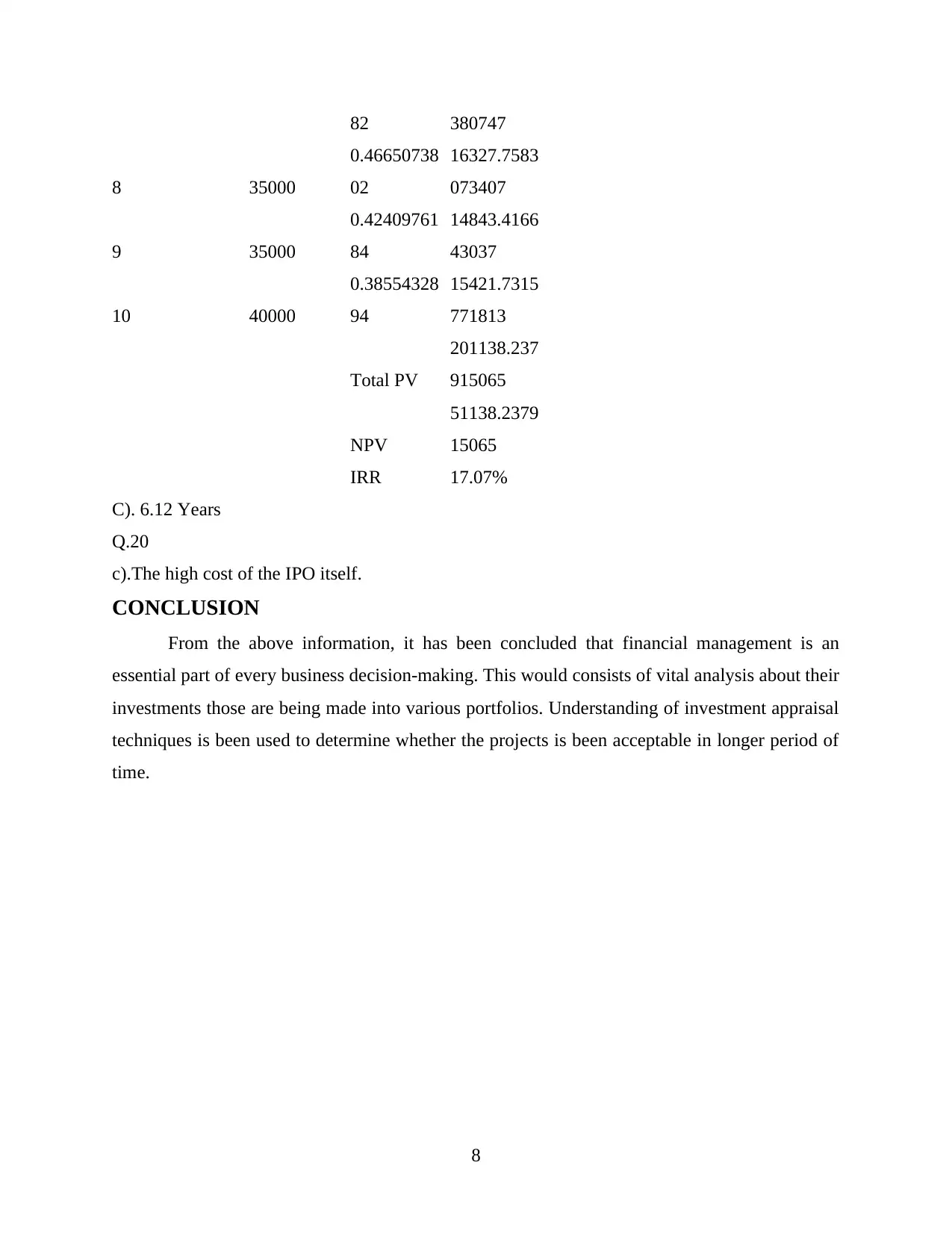
82 380747
8 35000
0.46650738
02
16327.7583
073407
9 35000
0.42409761
84
14843.4166
43037
10 40000
0.38554328
94
15421.7315
771813
Total PV
201138.237
915065
NPV
51138.2379
15065
IRR 17.07%
C). 6.12 Years
Q.20
c).The high cost of the IPO itself.
CONCLUSION
From the above information, it has been concluded that financial management is an
essential part of every business decision-making. This would consists of vital analysis about their
investments those are being made into various portfolios. Understanding of investment appraisal
techniques is been used to determine whether the projects is been acceptable in longer period of
time.
8
8 35000
0.46650738
02
16327.7583
073407
9 35000
0.42409761
84
14843.4166
43037
10 40000
0.38554328
94
15421.7315
771813
Total PV
201138.237
915065
NPV
51138.2379
15065
IRR 17.07%
C). 6.12 Years
Q.20
c).The high cost of the IPO itself.
CONCLUSION
From the above information, it has been concluded that financial management is an
essential part of every business decision-making. This would consists of vital analysis about their
investments those are being made into various portfolios. Understanding of investment appraisal
techniques is been used to determine whether the projects is been acceptable in longer period of
time.
8
Paraphrase This Document
Need a fresh take? Get an instant paraphrase of this document with our AI Paraphraser

REFERENCES
Books and Journals:
Ross, A. and Williams, P., 2012. Financial management in construction contracting. John Wiley
& Sons.
Oseifuah, E.K., 2013. Activity based costing approach to financial management in the public
sector: the South Africa experience. European Scientific Journal, ESJ. 9(1).
9
Books and Journals:
Ross, A. and Williams, P., 2012. Financial management in construction contracting. John Wiley
& Sons.
Oseifuah, E.K., 2013. Activity based costing approach to financial management in the public
sector: the South Africa experience. European Scientific Journal, ESJ. 9(1).
9
1 out of 11
Related Documents
Your All-in-One AI-Powered Toolkit for Academic Success.
+13062052269
info@desklib.com
Available 24*7 on WhatsApp / Email
![[object Object]](/_next/static/media/star-bottom.7253800d.svg)
Unlock your academic potential
Copyright © 2020–2025 A2Z Services. All Rights Reserved. Developed and managed by ZUCOL.





